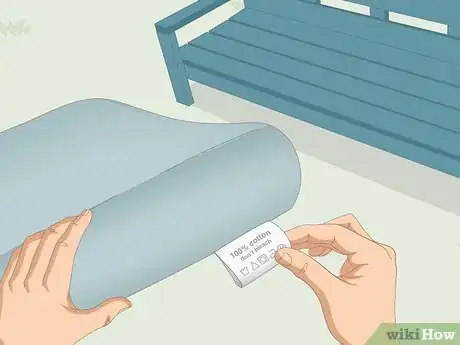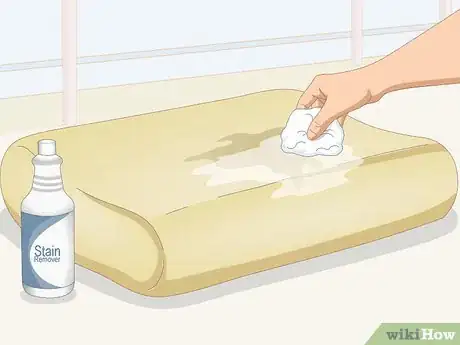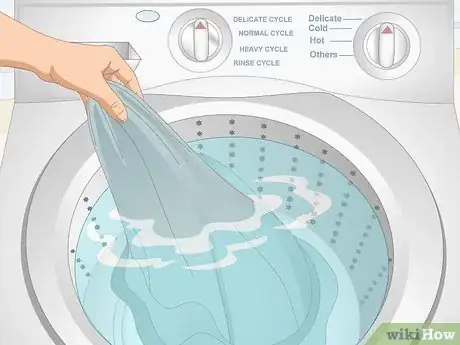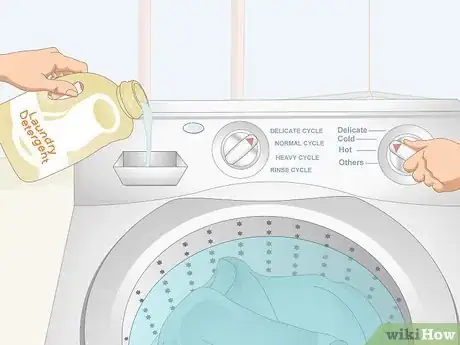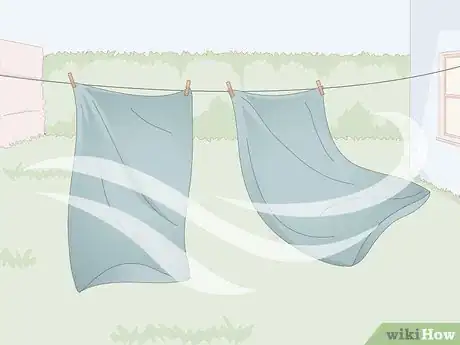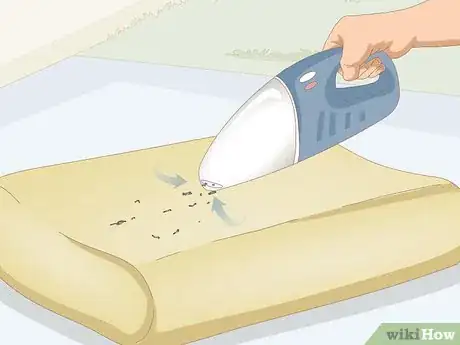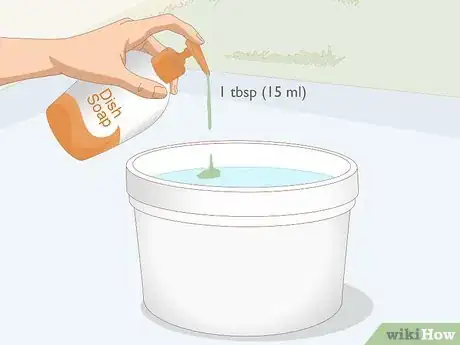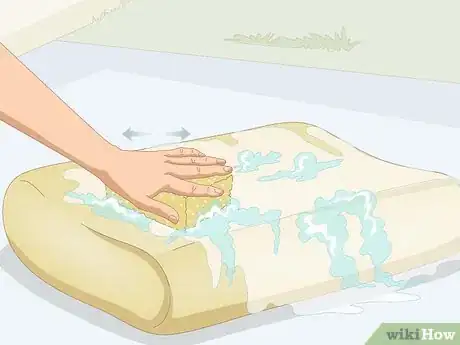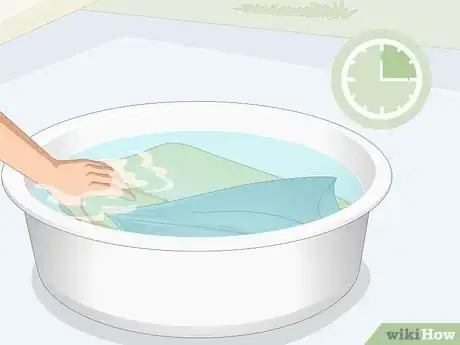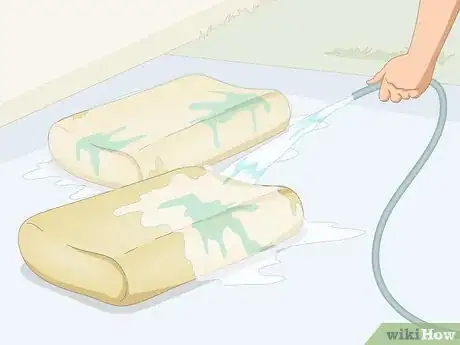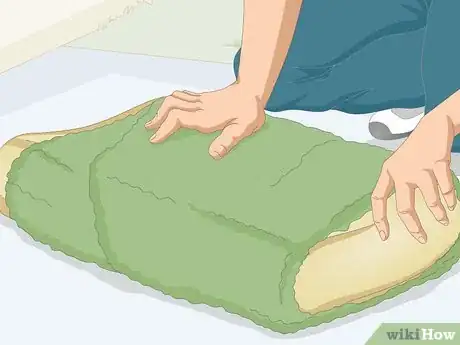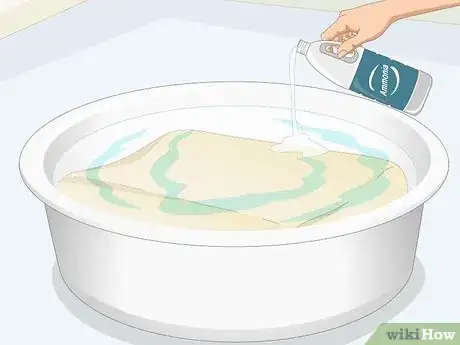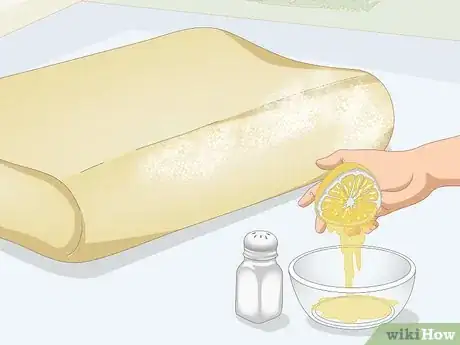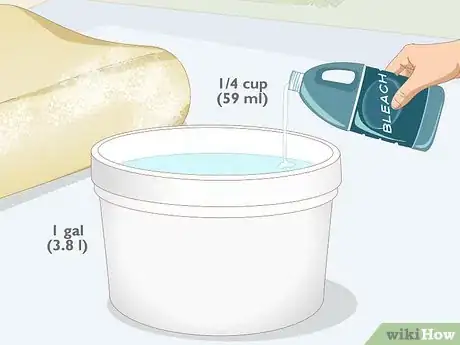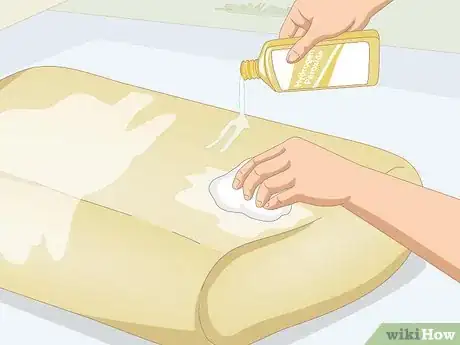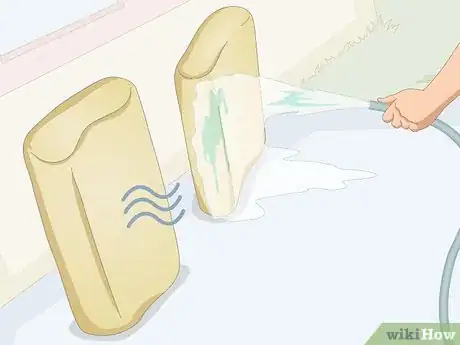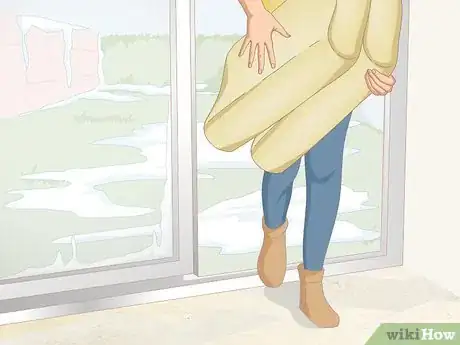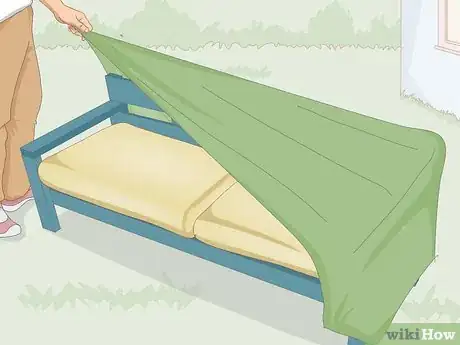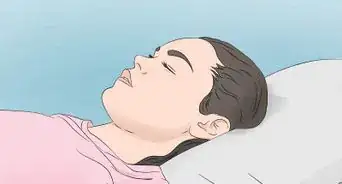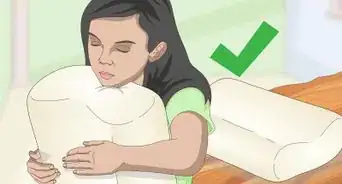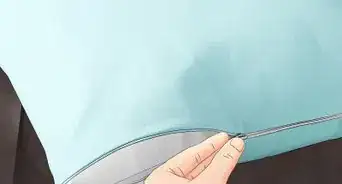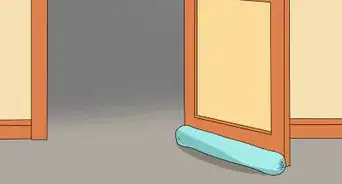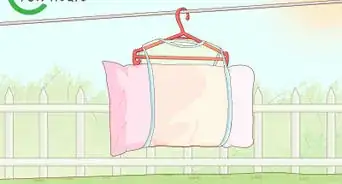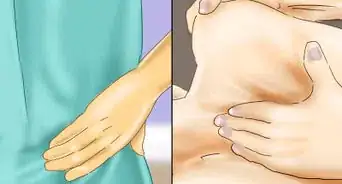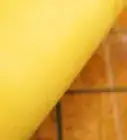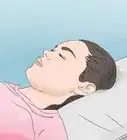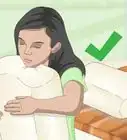X
This article was co-authored by wikiHow Staff. Our trained team of editors and researchers validate articles for accuracy and comprehensiveness. wikiHow's Content Management Team carefully monitors the work from our editorial staff to ensure that each article is backed by trusted research and meets our high quality standards.
This article has been viewed 36,333 times.
Learn more...
Outdoor cushions see the worst the weather has to offer, and can quickly get dirty, faded, and even moldy if you don’t wash them often. If you are struggling to find a way to clean off the cushions, you can use a few common household products to clean them off, remove mildew, and even keep them nice and dry.
Steps
Method 1
Method 1 of 4:
Putting Cushion Covers in the Washing Machine
-
1Check the cushion’s care tag. The manufacturer’s care tag on the cushion may have restrictions on whether or not you should machine wash the cover or the cushion itself. Each cushion and cover is different, and some have sensitive coatings that protect the fabric from damage.
- The tag will often provide detailed care instructions for you to follow.
- If either the covers, cushions, or the whole pillows suggest hand-washing, skip to the section on hand-washing your cushions.
-
2Remove the cushion covers, if possible. If the care tag for the covers suggests machine washing, you’ll need to take the covers off the cushions.[1]
- Shake out the covers before machine washing them to get rid of any debris or dirt trapped inside.
Advertisement -
3Pre-treat the cushions by rubbing a stain remover on large stains. If the cushions are especially stained, using a stain remover before throwing them in the wash will help the washing machine break down the stain. Stain removers can be found in most home goods stores.[2]
- You don’t need to rinse off the stain remover, as you will be washing the pillow immediately after removing the stains.
-
4Load the covers in the washing machine. If the care tag recommends machine-washing, simply place the covers in the washer. Be sure to follow any special instructions described on the care tag, like the machine specifications or the cycle to use.[3]
- You can throw the covers in with another load, or wash them on their own.
-
5Add detergent and set the machine on a cold, gentle cycle. Filling the cap to the lowest marking should be plenty for a small load of a few covers, unless they are large and bulky or especially dirty. Set the machine to gentle so that you don’t damage the fabric or fade the design.[4]
- Cold water is almost always a good idea for sensitive fabrics.
-
6Air-dry the covers or dry them on the lowest heat setting. Cushion covers may be damaged by high heat, so towel drying and then hanging them up to dry is the best way to keep them safe. If this is impractical, set the dryer to the lowest heat cycle you can.
Advertisement
Method 2
Method 2 of 4:
Hand Washing Outdoor Cushions
-
1Use a vacuum to get rid of dirt on the cushions themselves. Regardless of whether your cushions have covers, use the upholstery fixture on your vacuum to remove the loose dirt that your cushion is almost certainly covered in. This will quickly and thoroughly remove debris from the cushions.[5]
- If you don’t have an upholstery attachment, you can simply run the vacuum over the cover as it rests on the ground. Turn the cover inside out if possible to vacuum the inside as well.
-
2Add 1 tablespoon (15 mL) of dishwashing solution to a bucket of water. Combine the dish soap and 1 gallon (3.8 L) of warm water in a bucket, tub, or plastic bin. This will be the hand-washing solution for you to use as you clean the cushion and its cover.[6]
- Laundry detergent is too highly concentrated for use when washing fabrics by hand, but you may be able to find ready-made hand washing solutions at fabric or home goods stores.
-
3Scrub the suds onto the cushions with a sponge or soft brush. Use your hands to get dirt off and a soft-bristled brush, like the kind you would use to wash dishes, to rub the fabric until tough stains come off. The brush should be abrasive without feeling like it might tear the fabric.[7]
- If you use a sponge, rub vigorously on the cover so that it gets as clean as it would with a brush.
-
4Let the covers, and cushions if possible, soak in the solution for 15 minutes. If you have a large enough container, you can soak the entire cushions to help clean the insides. If you only have a bucket or other smaller container, just soak the covers in the solution.[8]
- You can weigh the covers down with a small, clean rock if they float to the top.
-
5Spray the cushions with a hose to rinse them off. To remove the suds, you’ll need to use a garden hose to rinse the cushions down. Be thorough and try to completely soak the cushions all the way through.[9]
- Never use a power or pressure washer on fabric, as it can create tears.
-
6Dry the cushions with a towel before letting them air dry. Squeeze out the water and then wrap a towel around the cushion to get rid of most of the moisture. Then, let the cushions air dry, sitting vertically on a dry towel.[10]
- Lean the cushions against a wall or other sturdy backing to keep mildew from forming on the underside.
Advertisement
Method 3
Method 3 of 4:
Removing Mold and Mildew
-
1Soak the cushions in water and Borax for 15 minutes. You can either add 1⁄4 cup (59 mL) of Borax to a hand-washing solution, or, if your cushions are especially covered in mold or mildew, you can create a separate Borax and water solution with 1⁄4 cup (59 mL) and 1 gallon (3.8 L) of water. Make the solution in a large container like a plastic bin or a tub so that you have room to soak the cushions.[11]
- You can add baking soda to help break up the mildew’s stains as well.
-
2Use an ammonia and water mixture if Borax isn’t available. One common household chemical that can get rid of mildew and mold is ammonia, which you can mix with water to clean your cushions. Adding 1 cup (240 mL) of ammonia to 1 gallon (3.8 L) of water in a large container creates a great solution for you to scrub mildew off cushions with a brush.[12]
- Be sure to use gloves when cleaning with ammonia.
-
3Mix 1 tablespoon (15 mL) of lemon juice and salt for a natural option. If you would rather stay away from household chemical solutions for health or safety reasons, a lemon salt mixture will do the job. Scrub the mixture into the fabric on spots with mildew and mold and watch it dissolve.[13]
- In this solution, citric acid from the lemon juice combines with salt to help break up the fungi, and the undissolved salt crystals act as an abrasive.
-
4Combine 1⁄4 cup (59 mL) of bleach and 1 gallon (3.8 L) of water. Scrubbing away mold and mildew with bleach will also sanitize the area and remove stains. While bleach alone can fade or discolor dark fabric, a mild bleach and water solution will most likely keep your colors safe.[14]
- If you are concerned about discoloration, you can add less bleach to the water.
- Never use a bleach solution if you used ammonia on the cushions, as this will create poisonous chemicals that are harmful to your health.
- Use gloves if you use bleach to clean your cushions.
-
5Dab hydrogen peroxide on newly clean spots to remove any smell. Mold and mildew can leave behind smells on your cushions that can be hard to remove. A few drops of hydrogen peroxide on each spot will break up the smell and help your outdoor cushions smell fresh and clean again.[15]
-
6Rinse the cushion with a hose and dry them. You’ll need to rinse mildew and high-power stain removers off the pillows before using them again. The chemicals in cleaning products can be harmful to your skin, so rinsing off the cushions under a hose will keep you safe.[16]
- Be sure to towel and air dry the cushions afterward.
Advertisement
Method 4
Method 4 of 4:
Protecting Your Outdoor Cushions
-
1Apply a coat of fabric sealer or protector. There are products available that will help waterproof or at least seal your cushions from water damage. Pick some up at a hardware or home and garden store, then spray it all over the cushion from around 3 feet (0.91 m) away.[17]
- This will help keep mold, mildew, and stains off your cushions and provide protection from sun damage or fading, too.
-
2Bring your cushions in when it rains or snows. During rainy or cold seasons, keep your cushions indoors or in a secure outdoor container to keep them dry and safe from freezing temperatures. Even during a brief summer storm, it is a good idea to put outdoor cushions in a safe, dry place.[18]
- Cushions under umbrellas are still vulnerable to rain. Bringing in the umbrella is a good idea, too, as it can also get rain damaged.
-
3Cover your cushions with a tarp. If you don’t want to bring outdoor cushions in, or if it is a hassle to detach them from a piece of furniture, you can use a tarp to cover up the fabric during wet and cold seasons. Large and small plastic tarps can be purchased at most hardware stores.[19]
- This won’t keep them completely dry, and you risk a bit of mildew, but it is much better than leaving them exposed to the elements year-round
Advertisement
Things You’ll Need
Using a Washing Machine
- Washing machine
- Laundry detergent
Hand-Washing the Cushions
- Vacuum cleaner with an upholstery attachment
- Soft-bristled brush
- Bucket or plastic bin
- Dish soap
- Warm water
- Garden hose
- Towels
Getting Rid of Mildew and Mold
- Borax
- Ammonia
- Lemon juice
- Salt
- Bleach
- Hydrogen peroxide
Protecting the Cushions
- Fabric sealer
- Outdoor container
- Tarp
References
- ↑ https://www.bobvila.com/articles/how-to-clean-patio-cushions/
- ↑ https://www.bobvila.com/articles/how-to-clean-patio-cushions/
- ↑ https://www.bobvila.com/articles/how-to-clean-patio-cushions/
- ↑ https://www.consumerreports.org/pillows/how-to-wash-a-pillow/
- ↑ https://www.bobvila.com/articles/how-to-clean-patio-cushions/
- ↑ https://www.bobvila.com/articles/how-to-clean-patio-cushions/
- ↑ https://www.bobvila.com/articles/how-to-clean-patio-cushions/
- ↑ https://www.bobvila.com/articles/how-to-clean-patio-cushions/
- ↑ https://www.cleanandscentsible.com/how-to-clean-patio-cushions/
- ↑ https://www.bobvila.com/articles/how-to-clean-patio-cushions/
- ↑ https://www.bobvila.com/articles/how-to-clean-patio-cushions/
- ↑ https://www.patioproductions.com/blog/how-to/remove-mold-and-mildew-from-patio-furniture/
- ↑ https://www.patioproductions.com/blog/how-to/remove-mold-and-mildew-from-patio-furniture/
- ↑ https://www.patioproductions.com/blog/how-to/remove-mold-and-mildew-from-patio-furniture/
- ↑ https://www.patioproductions.com/blog/how-to/remove-mold-and-mildew-from-patio-furniture/
- ↑ https://www.bobvila.com/articles/how-to-clean-patio-cushions/
- ↑ https://www.bobvila.com/articles/how-to-clean-patio-cushions/
- ↑ https://www.patioproductions.com/blog/how-to/patio-furniture-winter-maintenance/
- ↑ https://www.patioproductions.com/blog/how-to/patio-furniture-winter-maintenance/
About This Article
Advertisement
